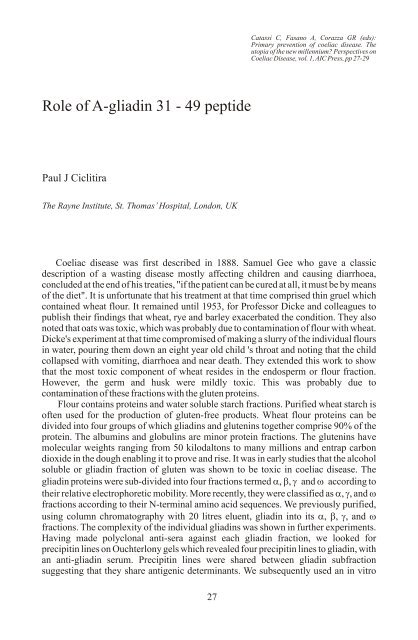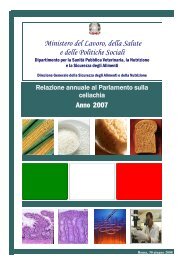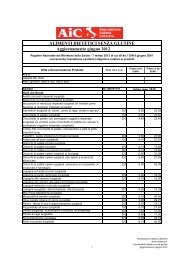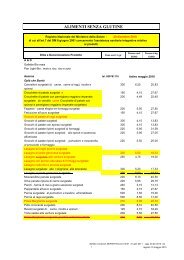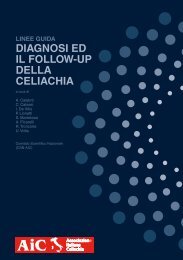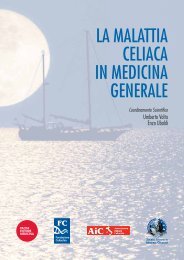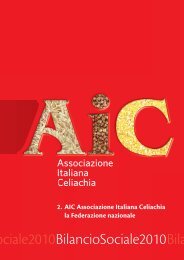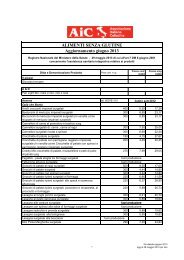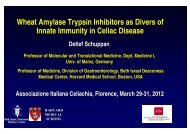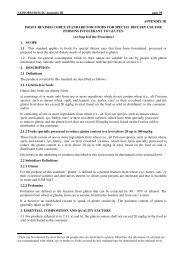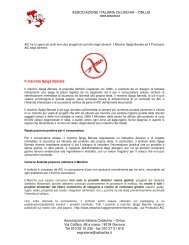primary prevention of coeliac disease - Associazione Italiana ...
primary prevention of coeliac disease - Associazione Italiana ...
primary prevention of coeliac disease - Associazione Italiana ...
Create successful ePaper yourself
Turn your PDF publications into a flip-book with our unique Google optimized e-Paper software.
Catassi C, Fasano A, Corazza GR (eds):<br />
Primary <strong>prevention</strong> <strong>of</strong> <strong>coeliac</strong> <strong>disease</strong>. The<br />
utopia <strong>of</strong> the new millennium? Perspectives on<br />
Coeliac Disease, vol. 1, AIC Press, pp 27-29<br />
Role <strong>of</strong> A-gliadin 31 - 49 peptide<br />
Paul J Ciclitira<br />
The Rayne Institute, St. Thomas’ Hospital, London, UK<br />
Coeliac <strong>disease</strong> was first described in 1888. Samuel Gee who gave a classic<br />
description <strong>of</strong> a wasting <strong>disease</strong> mostly affecting children and causing diarrhoea,<br />
concluded at the end <strong>of</strong> his treaties, "if the patient can be cured at all, it must be by means<br />
<strong>of</strong> the diet". It is unfortunate that his treatment at that time comprised thin gruel which<br />
contained wheat flour. It remained until 1953, for Pr<strong>of</strong>essor Dicke and colleagues to<br />
publish their findings that wheat, rye and barley exacerbated the condition. They also<br />
noted that oats was toxic, which was probably due to contamination <strong>of</strong> flour with wheat.<br />
Dicke's experiment at that time compromised <strong>of</strong> making a slurry <strong>of</strong> the individual flours<br />
in water, pouring them down an eight year old child 's throat and noting that the child<br />
collapsed with vomiting, diarrhoea and near death. They extended this work to show<br />
that the most toxic component <strong>of</strong> wheat resides in the endosperm or flour fraction.<br />
However, the germ and husk were mildly toxic. This was probably due to<br />
contamination <strong>of</strong> these fractions with the gluten proteins.<br />
Flour contains proteins and water soluble starch fractions. Purified wheat starch is<br />
<strong>of</strong>ten used for the production <strong>of</strong> gluten-free products. Wheat flour proteins can be<br />
divided into four groups <strong>of</strong> which gliadins and glutenins together comprise 90% <strong>of</strong> the<br />
protein. The albumins and globulins are minor protein fractions. The glutenins have<br />
molecular weights ranging from 50 kilodaltons to many millions and entrap carbon<br />
dioxide in the dough enabling it to prove and rise. It was in early studies that the alcohol<br />
soluble or gliadin fraction <strong>of</strong> gluten was shown to be toxic in <strong>coeliac</strong> <strong>disease</strong>. The<br />
gliadin proteins were sub-divided into four fractions termed a, b, gand waccording to<br />
their relative electrophoretic mobility. More recently, they were classified as a, g, and w<br />
fractions according to their N-terminal amino acid sequences. We previously purified,<br />
using column chromatography with 20 litres eluent, gliadin into its a,b, g, and w<br />
fractions. The complexity <strong>of</strong> the individual gliadins was shown in further experiments.<br />
Having made polyclonal anti-sera against each gliadin fraction, we looked for<br />
precipitin lines on Ouchterlony gels which revealed four precipitin lines to gliadin, with<br />
an anti-gliadin serum. Precipitin lines were shared between gliadin subfraction<br />
suggesting that they share antigenic determinants. We subsequently used an in vitro<br />
27


